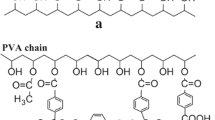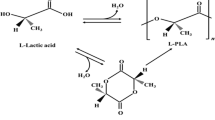Abstract
A novel series of cross-linked terpolymers synthesized from phenol, formaldehyde and four alkyldiamines via Mannich reaction in n-hexane at \({90^{\circ}}\)C is introduced for the removal of lead(II) ions in the concentration range of 50–136 mgL−1 from aqueous solutions. The synthesized terpolymers were characterized by spectroscopic techniques such as 13C-NMR, FT-IR and elemental analysis. The surface morphology, composition and crystallinity were investigated by scanning electron microscopy and powder X-ray. The adsorption of lead(II) ions was studied by batch equilibrium technique. The experimental data for the adsorption of lead(II) ions fitted Freundlich and Temkin isotherm models. The maximum adsorption capacity of lead(II) ions was found to be 222.2 mg g−1 for Ph–Buta with a removal of 98 % within 4 h of adsorption. Adsorption kinetics for Ph–Buta were investigated and fitted pseudo-second-order kinetic model. The adsorption mechanism was studied by intraparticle diffusion model and found to follow film diffusion and intraparticle diffusion simultaneously. The adsorption of lead(II) ions was spontaneous and endothermic in nature with an increase of adsorption capacity as temperature increased. Ph–Buta terpolymer showed high efficacy in the removal of toxic metal ions from spiked [1 mg L−1 solution of lead(II) ions] and unspiked wastewater samples with ~100 % removal of lead(II) ions. The excellent adsorption capacity of Ph–Buta provides a new, efficient adsorbent for treatment and separation of lead(II) ions from contaminated aqueous solutions and wastewater solutions.
Similar content being viewed by others
References
Dulcy Evangelin C., Gunasekaran S.G., Dharmendirakumar M.: Removal of lead ions from aqueous solutions by adsorption onto chemically modified silk cotton hulls by different oxidizing agents. Asia Pac. J. Chem. Eng. 8, 189–201 (2013)
Atia A.A., Donia A.M., Yousif A.M.: Removal of some hazardous heavy metals from aqueous solution using magnetic chelating resin with iminodiacetate functionality. Sep. Purif. Technol. 61, 348–357 (2008)
Mahdavi S., Jalali M., Afkhami A.: Heavy metals removal from aqueous solutions using TiO2, MgO, and Al2O3 nanoparticles. Chem. Eng. Commun. 200, 448–470 (2013)
Reagan P.L., Silbergeld E.K.: Establishing a health based standard for lead in residential soils. Trace Subst. Environ. Health 23, 199–238 (1990)
Boudrahem F., Aissani-Benissad F., Soualah A.: Kinetic and equilibrium study of the sorption of lead(II) ions from aqueous phase by activated carbon. Arab. J. Sci. Eng. 38(8), 1939–1949 (2013)
Edris G., Alhamed Y., Alzahrani A.: Biosorption of cadmium and lead from aqueous solutions by Chlorella vulgaris biomass: equilibrium and kinetic study. Arab. J. Sci. Eng. 39(1), 87–93 (2014)
Gharieb M., Al-Fakih A., Ali M.: Biosorption of Pb(II) and Co(II) ions from aqueous solutions using pretreated rhizopus oryzae (bread mold). Arab. J. Sci. Eng. 39(4), 2435–2446 (2014)
Bhatt, R.R.; Shah, B.A.: Sorption studies of heavy metal ions by salicylic acid–formaldehyde–catechol terpolymeric resin: isotherm, kinetic and thermodynamics. Arab. J. Chem. doi:10.1016/j.arabjc.2013.03.012
Jakubiak A., Owsik I.A., Kolarz B.N.: The oxidation of hydroquinone catalysed by Cu(II) ions immobilized on acrylic resins. The influence of ionic liquid. React. Funct. Polym. 65, 161–167 (2005)
Kolarz B.N., Jakubiak A., Jezierska J., Dach B.: Polymeric supports with amino groups from halogenoacetylated styrene/divinylbenzene copolymers. React. Funct. Polym. 68, 1207–1217 (2008)
Maurya M.R., Sikarwar S., Joseph T., Manikandan P., Halligudi S.B.: Synthesis, characterization and catalytic potentials of polymer anchored copper(II), oxovanadium(IV) and dioxomolybdenum(VI) complexes of 2-(α-hydroxymethyl)benzimidazole. React. Funct. Polym. 63, 71–83 (2005)
Gupta K.C., Sutar A.K.: Catalytic activities of polymer-supported metal complexes in oxidation of phenol and epoxidation of cyclohexene. Polym. Adv. Technol. 19, 186–200 (2008)
Gupta K.C., Sutar A.K.: Catalytic activity of polymer anchored N, N′-bis (o-hydroxy acetophenone) ethylene diamine Schiff base complexes of Fe(III), Cu(II) and Zn(II) ions in oxidation of phenol. React. Funct. Polym. 68, 12–26 (2008)
Ruiz M., Sastre A.M., Guibal E.: Palladium sorption on glutaraldehyde-crosslinked chitosan. React. Funct. Polym. 45, 155–173 (2000)
Fu F., Wang Q.: Removal of heavy metal ions from wastewaters: a review. J. Environ. Manag. 92, 407–418 (2011)
Lawson, F.; Jay, W.H.: Preparation of ion exchange resin distributed in a polyurethane matrix and its use for extraction of metal ions. WO9400237A1
Walker, F.H.; Vedage, G.A.; Cook, M.I.; Rasing, R.M.T.: Mannich base reaction product, amine curing agent for low temperature cure applications, amine composition and amine–epoxy composition. EP2108668A1
Ebraheem K.A.K., Hamdi S.T.: Synthesis and properties of a copper selective chelating resin containing a salicylaldoxime group. React. Funct. Polym. 34, 5–10 (1997)
Azarudeen R.S., Subha R., Jeyakumar D., Burkanudeen A.R.: Batch separation studies for the removal of heavy metal ions using a chelating terpolymer: Synthesis, characterization and isotherm models. Sep. Purif. Technol. 116, 366–377 (2013)
Ali S.A., Al Hamouz O.C.S., Hassan N.M.: Novel cross-linked polymers having pH-responsive amino acid residues for the removal of Cu2+ from aqueous solution at low concentrations. J. Hazard. Mater. 248, 47–58 (2013)
Dupre, F.C.; Foucht, M.E.; Freese, W.P.; Gabrielson, K.D.; Gapud, B.D.; Ingram, W.H.; McVay, T.E.; Rediger, R.A.; Shoemake, K.A.; Tutin, K.K.; Wright, J.T.: Preparation of cyclic urea–formaldehyde polymer–modified phenol–formaldehyde and melamine–formaldehyde resin-based binders and their uses. WO9932534A1
Lenghaus K., Qiao G.G., Solomon D.H.: The effect of formaldehyde to phenol ratio on the curing and carbonisation behaviour of resole resins. Polymer 42, 3355–3362 (2001)
Kishore N., Sachan S., Rai K.N., Kumar A.: Synthesis and characterization of a nanofiltration carbon membrane derived from phenol–formaldehyde resin. Carbon 41, 2961–2972 (2003)
Subramaniapillai S.G.: Mannich reaction: A versatile and convenient approach to bioactive skeletons. J. Chem. Sci. 125, 467–482 (2013)
Cavus S., Gurdag G.: Noncompetitive removal of heavy metal ions from aqueous solutions by poly[2-(acrylamido)-2-methyl-1-propanesulfonic acid-co-itaconic acid] hydrogel. Ind. Eng. Chem. Res. 48, 2652–2658 (2009)
Bellamy L.J.: The Infrared Spectra of Complex Molecules, 3rd edn. Chapman and Hall, London (1972)
Stuart B.H.: Infrared Spectroscopy—Fundamentals and Applications. Wiley, Chichester (2004)
Rego R., Adriaensens P.J., Carleer R.A., Gelan J.M.: Fully quantitative carbon-13 NMR characterization of resol phenol–formaldehyde prepolymer resins. Polymer 45, 33–38 (2004)
Georgakopoulos A.: Aspects of solid state 13C CPMAS NMR spectroscopy in coals from the Balkan Peninsula. J. Serb. Chem. Soc. 68, 599–605 (2003)
Chuang I.S., Maciel G.E., Myers G.E.: Carbon-13 NMR study of curing in furfuryl alcohol resins. Macromolecules 17, 1087–1090 (1984)
Muylaert I., Verberckmoes A., De Decker J., VanDer Voort P.: Ordered mesoporous phenolic resins: Highly versatile and ultra stable support materials. Adv. Colloid Interface Sci. 175, 39–51 (2012)
Hirst A.R., Smith D.K., Feiters M.C., Geurts H.P.M.: Two-component dendritic gel: effect of spacer chain length on the supramolecular chiral assembly. Langmuir 20, 7070–7077 (2004)
Blackwell J., Nagarajan M.R., Hoitink T.B.: Structure of polyurethane elastomers: effect of chain extender length on the structure of MDI/diol hard segments. Polymer 23, 950–956 (1982)
Mengistie A.A., Rao T.S., Rao A.V.P., Singanan M.: Removal of lead(II) ions from aqueous solutions using activated carbon from Militia ferruginea plant leaves. Bull. Chem. Soc. Ethiop. 22, 349–360 (2008)
Sheng P.X., Ting Y.-P., Chen J.P., Hong L.: Sorption of lead, copper, cadmium, zinc, and nickel by marine algal biomass: characterization of biosorptive capacity and investigation of mechanisms. J. Colloid Interface Sci. 275, 131–141 (2004)
Bradl H.B.: Adsorption of heavy metal ions on soils and soils constituents. J. Colloid Interface Sci. 277, 1–18 (2004)
de Oliveira Vaz D., Fernandes A.N., Szpoganicz B., Sierra M.M.D.: Potentiometric quantification and speciation of oxygenated groups in humic substances using BEST7 software. Ecletica Quim. 35, 1–7 (2010)
Zhu Y., Hu J., Wang J.: Competitive adsorption of Pb(II), Cu(II) and Zn(II) onto xanthate-modified magnetic chitosan. J. Hazard. Mater. 221-222, 155–161 (2012)
Kampalanonwat P., Supaphol P.: Preparation and adsorption behavior of aminated electrospun polyacrylonitrile nanofiber mats for heavy metal ion removal. ACS Appl. Mater. Interfaces 2, 3619–3627 (2010)
Shaaban A.F., Fadel D.A., Mahmoud A.A., Elkomy M.A., Elbahy S.M.: Synthesis of a new chelating resin bearing amidoxime group for adsorption of Cu(II), Ni(II) and Pb(II) by batch and fixed-bed column methods. J. Environ. Chem. Eng. 2, 632–641 (2014)
Khalili S., Ghoreyshi A.A., Jahanshahi M., Pirzadeh K.: Enhancement of carbon dioxide capture by amine-functionalized multi-walled carbon nanotube. Clean Soil Air Water 41, 939–948 (2013)
Tay T., Candan M., Erdem M., Cimen Y., Turk H.: Biosorption of cadmium ions from aqueous solution onto non-living lichen Ramalina fraxinea biomass. Clean Soil Air Water 37, 249–255 (2009)
Hsueh C.-L., Lu Y.-W., Hung C.-C., Huang Y.-H., Chen C.-Y.: Adsorption kinetic, thermodynamic and desorption studies of C.I. Reactive Black 5 on a novel photoassisted Fenton catalyst. Dyes Pigm. 75, 130–135 (2007)
Boparai H.K., Joseph M., O’Carroll D.M.: Kinetics and thermodynamics of cadmium ion removal by adsorption onto nano zerovalent iron particles. J. Hazard. Mater. 186, 458–465 (2011)
Subha R., Namasivayam C.: Kinetics and isotherm studies for the adsorption of phenol using low cost micro porous ZnCl2 activated coir pith carbon. Can. J. Civ. Eng. 36, 148–159 (2009)
He Z.-Y., Nie H.-L., Branford-White C., Zhu L.-M., Zhou Y.-T., Zheng Y.: Removal of Cu2+ from aqueous solution by adsorption onto a novel activated nylon-based membrane. Bioresour. Technol. 99, 7954–7958 (2008)
Ma X., Li L., Yang L., Su C., Wang K., Yuan S., Zhou J.: Adsorption of heavy metal ions using hierarchical CaCO3–maltose meso/macroporous hybrid materials: Adsorption isotherms and kinetic studies. J. Hazard. Mater. 209-210, 467–477 (2012)
Unuabonah E.I., Adebowale K.O., Olu-Owolabi B.I.: Kinetic and thermodynamic studies of the adsorption of lead(II) ions onto phosphate-modified kaolinite clay. J. Hazard. Mater. 144, 386–395 (2007)
Coşkun R., Soykan C., Saçak M.: Removal of some heavy metal ions from aqueous solution by adsorption using poly(ethylene terephthalate)-g-itaconic acid/acrylamide fiber. React. Funct. Polym. 66(6), 599–608 (2006)
Júnior, O.K.; Gurgel, L.V.A.; Freitas, R.P.de ; Gil, L.F.: Adsorption of Cu(II), Cd(II), and Pb(II) from aqueous single metal solutions by mercerized cellulose and mercerized sugarcane bagasse chemically modified with EDTA dianhydride (EDTAD). Carbohydr. Polym. 77(3), 643–650 (2009)
Singh V., Tiwari S., Sharma A.K., Sanghi R.: Removal of lead from aqueous solutions using Cassia grandis seed gum-graft-poly(methylmethacrylate). J. Colloid Interface Sci. 316(2), 224–232 (2007)
Wang J.-W., Kuo Y.-M.: Preparation of fructose-mediated (polyethylene glycol/chitosan) membrane and adsorption of heavy metal ions. J. Appl. Polym. Sci. 105(3), 1480–1489 (2007)
Chen A.-H., Yang C.-Y., Chen C.-Y., Chen C.-Y., Chen C.-W.: The chemically crosslinked metal-complexed chitosans for comparative adsorptions of Cu(II), Zn(II), Ni(II) and Pb(II) ions in aqueous medium. J. Hazard Mater. 163(2–3), 1068–1075 (2009)
Author information
Authors and Affiliations
Corresponding author
Rights and permissions
About this article
Cite this article
Al Hamouz, O.C.S. Synthesis and Characterization of a Novel Series of Cross-Linked (Phenol, Formaldehyde, Alkyldiamine) Terpolymers for the Removal of Toxic Metal Ions from Wastewater. Arab J Sci Eng 41, 119–133 (2016). https://doi.org/10.1007/s13369-015-1622-0
Received:
Accepted:
Published:
Issue Date:
DOI: https://doi.org/10.1007/s13369-015-1622-0




